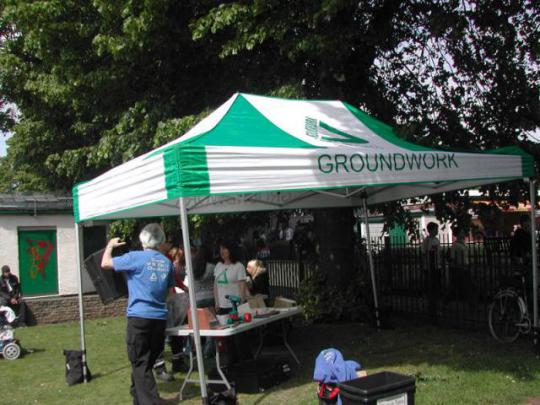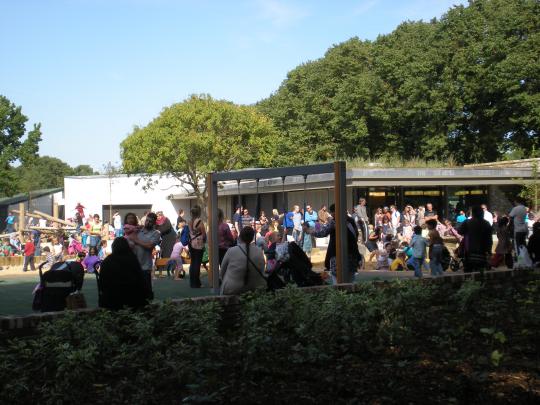The Friends of Lloyd Park was formed in 2004 to represent park users in the ongoing management and development of Lloyd Park and Aveling Park. Some of the aims of membership are:
- To find out the needs of users of all ages and put forward ideas for future development;
- To highlight day to day problems and improve security;
- To lobby councillors and ensure coordination between council departments and the various park users;
- To referee between competing interests ensuring tax payers’ money is well spent;
- To keep up to date with each other about news and events by having a regular newsletter and regular public meetings where users can express their views.
- To work with the council on the lottery bid to refurbish the park
Would you like to support and improve Lloyd Park? Or help run events and activities, so others can enjoy Lloyd Park as much as you do? The Friends of Lloyd Park is welcoming new members who want to get active in their park.
Lloyd and Aveling park has been a favourite place for Walthamstow residents since 1900 and was once home to William Morris.
Friends of Lloyd Park also have their own dedicated website.
Contact details
Email: folpe17@gmail.com
Facilities
Lloyd Park and adjoining Aveling Park provide a large range of leisure, sporting, educational and cultural facilities. Formal gardens and recreational green spaces are complemented by a cafe; facilities for tennis, bowling, skateboarding and basketball practice; three childrens’ play areas; a sensory garden; an aviary and an historical moat – complete with ducks and geese.
Cultural facilities include the nationally important William Morris Gallery; the Waltham Forest Theatre; and the Changing Room Gallery and artists studios.
Educational establishments within the park include the newly-expanded Lloyd Park Under Fives Centre and Aveling Park Secondary School.
A collection of beautiful and well-established trees and other plants are supplemented by seasonal planting displays. These are undertaken by the parks’ overall managers the London Borough of Waltham Forest Greenspace Group.
Location
History
Lloyd Park has been a favourite recreational place for Walthamstow residents since it was officially opened on 28th July 1900.
Although the estate has probably been in existence from the 16th century, the name of Lloyd Park was only established when the grounds were opened as a park.
The newspaper publisher Frank Lloyd had given the house and gardens to the Walthamstow Urban District Council, to be used by the public as a recreation ground – providing the council bought some adjoining land to be used as playing fields.
The estate, which had seen many name changes over the years including Cricklewood, Hawkes Capp, Whinnes Cap, Whynnes and The Winns, was renamed in honour of its benefactor.
The council made various changes to the grounds and house, laying out the new flowerbeds and adding a new terrace at the back of the house, which had lawns extending down to the island. The rectangular moat is one of the oldest recorded Historical Monuments in Walthamstow.
The island was already planted with numerous trees including aspens, hollies, and chestnuts, and also had a boathouse and two fishponds. In 1912 the council purchased a further 16 acres of the Aveling Park estate as an extension to the park.
During the early days of the Park there was a Bandstand on the island, which later gave way to a concert pavilion. The current theatre was built in 1937 but has been enlarged and altered over the years. Early park amenities included a grotto, shelters, toilets, refreshments kiosk, rockery, fish pool, drinking fountains, and an Attendants Office (park keepers).
In the lower field – Aveling Park – there was another bandstand as well as a sports pavilion that was used for the Walthamstow schools district sports day. From 1905 to 1910 The Walthamstow Avenue Football Club had their home pitch in the park. A children’s playground was built in the Aveling Park section in the 1930s and the Aveling Park School (formerly William Fitt) was built in 1962, on land previously occupied by prefabs.
The present Mansion house dates from 1760 but there was probably an earlier house on the site. Between 1911 and 1943 the house was used as offices for children’s medical and dental services, and school attendance departments. It has been known as The Water House, Lloyd Park Mansion and latterly William Morris Gallery, after its most famous inhabitant.
The house was turned into a Museum of Morris’ life and works in 1950, the collection being complemented by works from other Victorian and later artists.
Gallery






